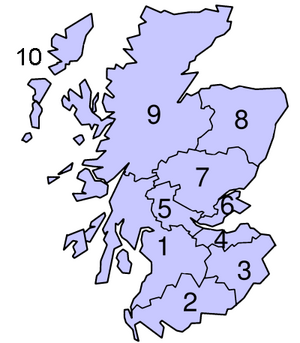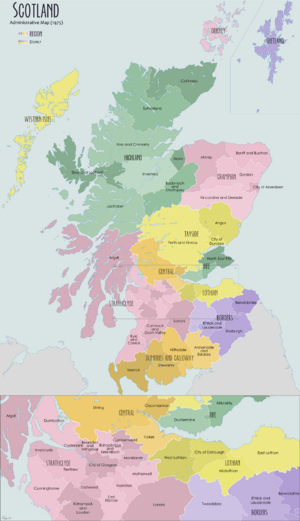Local government areas of Scotland (1975–1996) facts for kids
The local government areas of Scotland are how Scotland is divided up for local services. These areas were changed a lot by two important laws: the Local Government (Scotland) Act 1973 and the Local Government etc (Scotland) Act 1994.
The 1973 law created a new system in 1975. It set up nine large areas called regions and three special islands areas. This new system completely replaced the older ways Scotland was divided, like counties and burghs (towns with special rights). The new regions were very different from the old counties.
Contents
Why Scotland's Local Government Changed
For a long time, people in Scotland thought that the way local services were managed needed to be updated. In the mid-1960s, the government started looking into this.
Ideas for Change
In 1963, the Scottish Office (a government department) suggested a big change. They wanted to have fewer local councils, maybe only 10 to 15 instead of 33. They also wanted new "second-tier councils" where towns (burghs) would join with the countryside around them. The idea was to make local government more efficient. However, many groups, including the Scottish Labour Party, didn't agree with these plans, so they weren't put into action.
The Wheatley Report
Because the first ideas didn't work out, a special group called a royal commission was set up in 1966. This group was led by Lord Wheatley. Their job was to figure out the best way to organize local services for a long time to come.
The commission finished its report in 1969. It suggested a two-part system: 7 large regions and 37 smaller districts. The government liked this idea. After more discussions, they decided on 9 regions and 53 districts. The islands of Orkney, Shetland, and the Western Isles were given special status as "islands areas." This meant they would manage all their local services themselves.
New Councils Begin
The new system was officially created by the Local Government (Scotland) Act 1973. The first elections for these new councils happened in May 1974. The elected councillors worked as "shadow authorities" for a year, getting ready. Then, on May 16, 1975, the new regions and districts officially took over.
How the System Worked
Regions: Big Decisions
The regions had a "two-tier" system. This means there were two levels of local government. The top level was the regional council. These councils were in charge of services that needed a lot of money or covered a large area.
- Services provided by regional councils:
* Police * Fire services * Education * Public transport * Consumer protection
Districts: Local Services
Each region was divided into several districts. These districts had their own elected district councils. District councils handled services that were more local and specific to smaller areas.
- Services provided by district councils:
* Local planning (deciding where buildings can go) * Housing * Libraries * Licensing (like for shops or taxis)
Some districts, like Aberdeen, Dundee, Edinburgh, and Glasgow, were also cities. This gave them "city status," but it didn't give them extra powers.
Islands Areas: All in One
The three islands areas (Orkney, Shetland, and the Western Isles) were different. They were "unitary" areas. This means they had only one council that managed all local services, both the big ones (like regions) and the local ones (like districts).
Regions and Islands Areas of Scotland (1975-1996)
Here's a list of the regions and islands areas, along with their main towns and populations:
| No. on map |
Region or islands area | Headquarters | Population (1994) estimate |
|---|---|---|---|
| 1 | Strathclyde (region) | Glasgow | 2,286,800 |
| 2 | Dumfries and Galloway (region) | Dumfries | 147,900 |
| 3 | Borders (region) | Newtown St Boswells | 105,300 |
| 4 | Lothian (region) | Edinburgh | 750,600 |
| 5 | Central (region) | Stirling | 272,900 |
| 6 | Fife (region) | Glenrothes | 351,200 |
| 7 | Tayside (region) | Dundee | 395,200 |
| 8 | Grampian (region) | Aberdeen | 528,100 |
| 9 | Highland (region) | Inverness | 206,900 |
| 10 | Western Isles (islands area) | Stornoway | 29,600 |
| Not shown | Shetland (islands area) | Lerwick | 22,522 |
| Not shown | Orkney (islands area) | Kirkwall | 19,600 |
Districts of Scotland (1975-1996)
Each region was divided into smaller districts. Here are some examples of districts within each region:
The End of the Regions and Districts
The system of regions and districts lasted for about 21 years. In 1994, a new law, the Local Government etc (Scotland) Act 1994, changed things again. This law created 29 new "unitary" local government areas. These new areas replaced the regions and districts completely on April 1, 1996. The three islands areas continued as they were. Today, Scotland has 32 council areas.
See also
- List of burghs in Scotland
- Counties of Scotland
- Lieutenancy areas of Scotland
- Subdivisions of Scotland
- List of places in Scotland
- Local government in the United Kingdom



